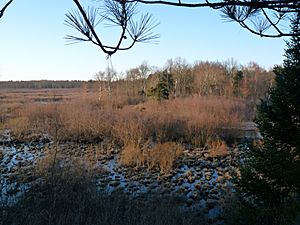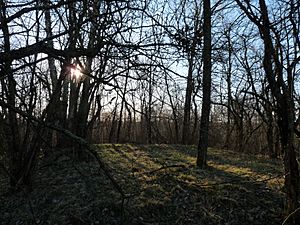Big Indian Farms facts for kids
Quick facts for kids |
|
|
Big Indian Farms
|
|
 |
|
| Location | Perkinstown, Wisconsin |
|---|---|
| NRHP reference No. | 87001827 |
| Added to NRHP | July 11, 1988 |
Big Indian Farms is a special place in the Chequamegon Forest in Wisconsin. From about 1896 to 1908, around 130 Potawatomi people and others lived here. It was a remote clearing where they could keep their traditional culture alive. This was important because they were away from the direct influence of the Bureau of Indian Affairs and reservations.
The site was added to the National Register of Historic Places in 1988. This means it is recognized as an important historical place.
A Look Back: Native Americans in Wisconsin
The forests and rivers of northern Wisconsin have been home to different Native American groups for a very long time. The Ojibwe people were the last main group to live in this area. However, they sold their land rights to the U.S. government in 1837. This agreement was called the "White Pine Treaty."
This treaty was part of a bigger plan to move Native Americans west of the Mississippi River. The government wanted the land in the east for mining, logging, and new settlers. Most of the Ojibwe eventually moved to reservations further north. By the late 1800s, only a few Native Americans remained in Taylor County, Wisconsin. Most of them worked in the logging industry.
The Potawatomi people did not originally live in this part of Wisconsin. Their traditional lands were in southern Wisconsin, Illinois, Indiana, and Michigan. Through treaties in 1821 and 1833, they gave up most of their lands. In return, they were promised money and land west of the Mississippi.
During the 1830s, many Potawatomi moved to reservations in Kansas and Nebraska. Some were even forced to move. The U.S. government wanted Native Americans to adopt American ways of life. This was called "assimilation." On reservations, their traditional Midewiwin religion was discouraged. Many children were sent to American Indian boarding schools. At these schools, they were often not allowed to speak their native language. They also learned little about their parents' culture.
But some Potawatomi managed to avoid these forced moves. Others went to reservations but were not happy there. They came back to live off the reservations. These groups were sometimes called "stray bands." They lived in less settled areas and moved when settlers came too close.
Finding a Safe Place
In 1896, a small group of Native Americans passed through Medford, Wisconsin. At first, local newspapers were interested. But the next summer, more Native Americans arrived. The newspapers started to complain.
One newspaper reported that about 100 Native Americans were camping near the Yellow River. They were hunting deer and gathering hay for their ponies. The newspaper noted that they did not belong to any reservation.
This first camp was near what is now the Chequamegon Waters Flowage. Perhaps because of unhappy settlers, the group soon moved. They found a more remote spot, which is now known as Big Indian Farms.
The village was built on a high, grassy meadow. This area likely had few settlers. Nearby marshes offered muskrats, fish, and waterfowl. Deer and other animals were likely plentiful in the surrounding cut-over forests.
The people at Big Indian Farms were resourceful. They built raised garden beds and grew corn, onions, beans, squash, and potatoes. They also gathered wild ginseng from the woods. In spring, they tapped sugar maple trees to make syrup. Some lived in log cabins, while others likely used more traditional homes.
Most people at Big Indian Farms were Potawatomi. Their respected elder was named John Young (Nsowakwet). A short distance north, a smaller group of Ojibwe lived. They were led by Paul Whitefish at a place called Little Indian Farm.
Before 1896, John Young and many of his followers lived at a similar village. It was called Indian Farms and was near Rozellville, Wisconsin. These Potawatomi were part of the Prairie Band Potawatomi Nation. This group had been assigned to a reservation in Kansas. John Young was a spiritual leader. He helped bring the Dream Dance to Kansas.
The Dream Dance (also known as Drum Dance or Dream Religion) began with a Dakota woman. It spread among many tribes. This dance was a way to bring Native American culture back to life. Big Indian Farms had a special dance ring on a hill. The Dream Dance was almost certainly performed there. Other dances, like a Sugar Dance in spring, also took place.
Sadly, Smallpox hit the village in the winter of 1900-1901. Between 60 and 80 people died. This was part of a larger outbreak. The people at Indian Farms were especially vulnerable. An Indian Agent in Kansas wrote about the tragedy. He noted that the people were without proper food, clothing, or medical care.
The half who survived buried their dead and continued their lives.
Relations with white neighbors were sometimes good, sometimes difficult. One older settler remembered getting along well with the group. He even went to some of their powwows. He said the Native American women would trade berries and wild foods for milk, eggs, or chickens. The Native Americans also traded in Westboro. John Young himself was once arrested for hunting deer without permission. He was held in jail in Medford.
Around 1908, the last Native Americans left Big Indian Farms. John Young and many of his followers moved to McCord Village. They eventually became part of the Forest County Potawatomi Community. The Whitefish family moved to Diamond Lake near Lublin.
Big Indian Farms Today
After the Native Americans left, a farmer plowed much of the clearing. For many years, people looking for old items dug in the burial mounds. However, much of the surrounding area, including Little Indian Farm, remains mostly untouched. It looks much like the Native Americans left it over a hundred years ago.
Today, you can still see the burial mounds. You can also see the outlines of old cabins. There's even a hint of the dance ring. In the nearby woods, you might find man-made mounds that were likely garden beds.
The site is not easy to visit. In summer, it has many mosquitoes, wood ticks, and poison ivy. But Big Indian Farms tells an important story. It shows how Native Americans found ways to keep their culture alive. They did this even when faced with challenges from the surrounding society.



